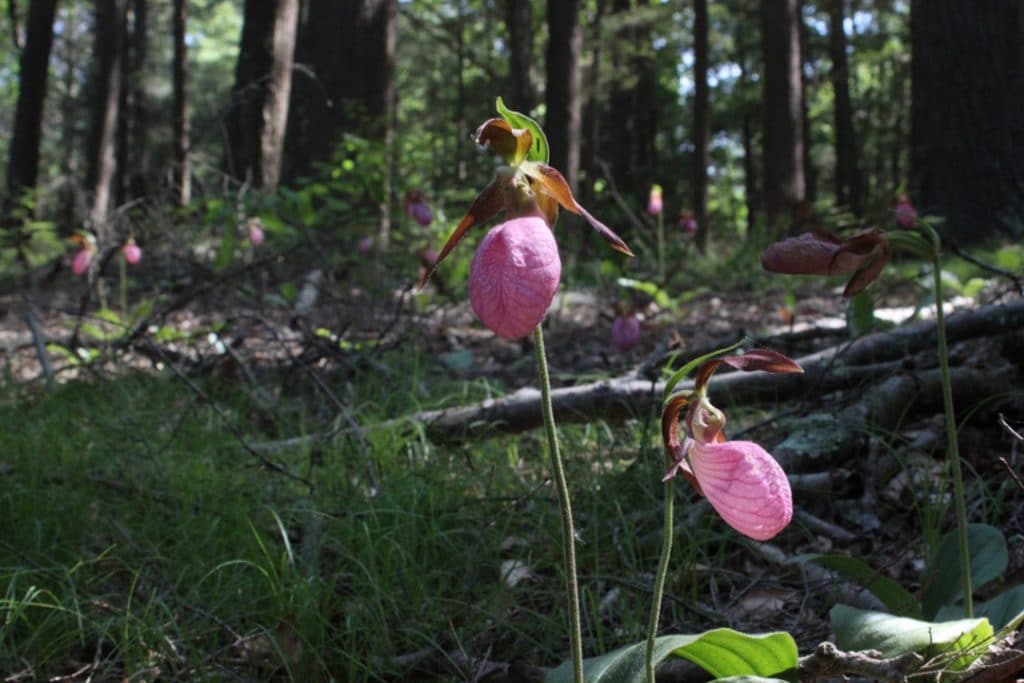Updated September 1, 2016
All trails on our preserves are in the process of being clipped of encroaching vegetation and cleared of woody material. Oftentimes in mixed hardwood coniferous forest, an eastern hemlock bordering a trail will branch out into the opening and need to be trimmed back. One consideration to take into account is that a hemlock branch will have its needles through the winter, catch snow, and bow down into the corridor with the extra weight, which can make travel a little tricky for cross-country skiers.
Many of the hemlock branches cut so far have had signs of woolly adelgid infestation. The woolly adelgid is an aphid-like insect from Asia that develops through six life stages – egg, 4 nymphal instars, and adult. The first instar nymphs crawl in search of a host tree and once finding it, remain there, feeding on young tissue of outer twigs and starches vital to the tree’s fitness. It may also inject toxins while feeding, enhancing needle drop and branch die back. Individuals are parthenogenetic, meaning they are all female and capable of reproducing without mating. There are two generations a year (fall-winter-spring and spring-early summer).
What I have been noticing on the underside of branch tips are white “wool-looking” masses. These are ovisacs created by adults with wax filaments to protect themselves and their eggs. Another sign of infestation are needles grayish green in color, instead of the deep, dark shiny green of our beloved conifer. Mortality of hemlock stands has a significant impact on the ecosystem. Their ability to shade and provide cover create habitat for wildlife and especially fish, being such a prevalent tree species in watersheds and riparian zones. Ecological processes like stream temperature regulation, leaching, nutrient cycling, and decomposition will be affected by the shift in forest species composition. Moccasin flower’s, or pink lady’s slippers, prefer the partial shade and acidic environments offered by hemlocks. Huge congregations like the one pictured below will surely be more scarce without hemlocks in the forest.

After just recently going through old VISTA newsletters, I have been educated on the closely watched development of this invasive species in Steep Rock and our collaboration with the CT Agricultural Experiment Station in its control. The titles are nicely summarized. CT Agricultural Experiment Station’s primary researcher will be returning to Steep Rock preserves this fall for the first time since 2005 to assess the status of adelgid and ladybeetle populations.
- Fall 1987 The Hemlock Woolly Adelgid Threatens Steep Rock Grove
- Spring 1995 Lookout For The Woolly Adelgid
- Spring 1998 Woolly Adelgid Identified In Steep Rock
- Dr. Mark McClure of CT Ag Station observes infested trees at Steep Rock Summit and releases 10,500 predatory ladybeetles (Sasajiscymnus tsugae)
- Spring 1999 More Adelgid Found, Beetles Are Reproducing
- Adelgids have spread through Clamshell to Hauser Bridge, 5,000 ladybeetles released in Hidden Valley
- Spring 2002 Hemlocks Doing Well, Adelgid On Decline, Beetles Reproducing
- Spring 2005 Outlook Hopeful For Hemlock Recovery
- Dr. Carole Cheah takes over Dr. McClure’s research, documents abundant new shoot growth and low percentage of adelgid-infested crowns in Steep Rock impacted areas
- Connecticut is first state to document biological control program having measurable impact on hemlock health

